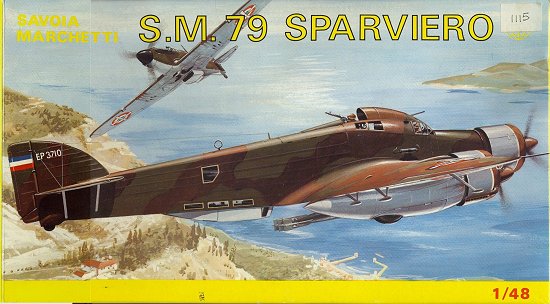
SMER 1/48 SM.79 Pipistrello
|
KIT # |
|
|
PRICE: |
$15.00 |
|
DECALS: |
Used Sky Models Decals |
|
REVIEWER: |
|
|
NOTES: |

|
HISTORY |
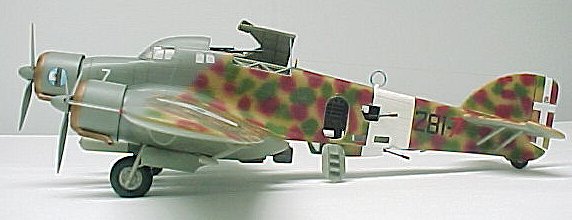
The SM-79 was realized from the hope of entering the new design into a race sponsored by the Australian tycoon Sir Mac Pherson Robertson. The trophy, and prize, would go to a transport aircraft with the shortest recorded time between London and Melbourne. On February 21, 1933, in response to the announcement of the race, Marchetti signed the drawings for the new aircraft. The plane was to be design with a low wing, slender body, tri-motors, and a retractable landing gear (a first in Italian design). (However the plane was not completed in time for this race.)
On October 8, 1934, the SM-79 made its maiden flight. The aircraft was found to be mechanically, structurally, and aerodynamically sound. However, poor engine performance kept the plane from reaching acceptable performance. Engines were switched, with minor reengineering, to Alfa Romeo 125R. This change was immediately noticed. The SM-79 was officially accepted on the 20th of June 1935. The machine impressed its pilots with its speed and exceptional stability.
 After informal talks between SIAI and top brass of the
Air Ministry, work began on developing a bomber version. Shortly there after,
an order for 24 bomber aircraft was placed. On July 7, 1936 the first bomber
was test flown.
After informal talks between SIAI and top brass of the
Air Ministry, work began on developing a bomber version. Shortly there after,
an order for 24 bomber aircraft was placed. On July 7, 1936 the first bomber
was test flown.
The SM-79 first experienced combat in Spain in February of 1937 when 61 aircraft were sold to the Aviacion National. These planes made up four Grupos and were used extensively for the remainder of the Spanish Civil War. During the war the SM-79 flew over 2500 missions and encountered enemy aircraft during 100 different engagements. Even so, not a single SM-79 was lost in the conflict due to enemy fighters. This was due to the fact that the SM-79’s speed was faster than almost all of the opposing fighters. In fact, only four aircraft were lost during the war. Spain continued to use the SM-79 by until 1954.
In April of 1939, the SM-79 went back to war over
Albania (although, the plane didn’t drop single a bomb), this time in service
with the Regia Aeronuatica. After the entry into WWII (June 1940) the SM-79
was used to attack France. SM-79s were stationed throughout the Mediterranean
theater and saw little opposition at first. In the early times of WWII the
SM-79’s main opponent was in the form of the Gloster Gladiator. However, as
these aircraft were replaced with Hurricanes and Spitfires, the SM-79 began to
have more and more trouble.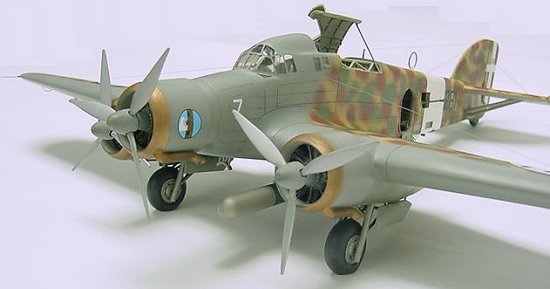
On July 25, 1940, a Torpedo-Bombing Experimental Unit was formed. Initially, 6 aircraft were modified and on August 15, the first attack as a torpedo-bomber was launched. The first (actually the first four) attack(s) was unsuccessful. However, on September 17 the cruiser HMS Kent was successfully hit. The HMS Kent was not sunk, but was put out of action for a year’s time. As aircraft were converted and crews trained, the SM-79 began to have more and more success against the Royal Navy. The SM-79 soon became the biggest threat to the Royal Navy.
After the war, several countries flew the SM-79. In all, some 1,332 aircraft were built. The SM-79 was an aircraft that was able to maintain combat effectiveness through a long span of years, even though its opposition’s aircraft improved at a faster pace. The SM-79 is arguable the most important aircraft the Italians had during the Second World War.
|
THE KIT |
Currently there are three models available in the 1/48th scale. One is a resin kit that was originally an EP Models kit that is now made by Vintage Models. Then, there is a recent kit that was released in around December of 2001 by Classic Airframes. I have not seen the resin kit, however I have seen the Classic Airframes kit on reviews from MM and Hyperscale. The newest kit looks great built but as with all kits, if you pick on them long enough you will find problems/shortcomings. Smer kits have a pretty bad reputation overall, but (until recently) some of their aircraft can’t be found anywhere else. Recently, I have seen this kit quoted as “ill-fitting, inaccurate an more trouble than it has ever been worth….the SMER kit doesn’t even qualify any longer as a Jurassic doorstop.” (Words of Tom Cleaver, who does great kits for MM on line magazine).
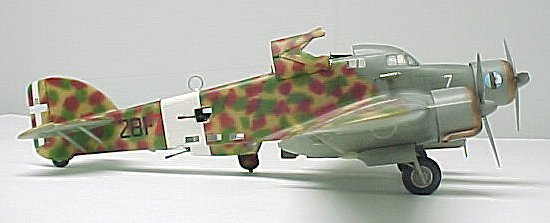 The Smer kit
built by this author was acquired from a friend’s father’s collection back in
2000. I wasn’t aware of what I was getting into when my friend handed me the
kit and I said “thank you,” and he replied “don’t thank me yet.” I spent the
next year finding all the little nick-knacks that I could use in the
construction of the kit. I had already built the Smer RE-2000 and noticed that
the kit was actually in 1/50 scale. Knowing this I created a Cad drawing of the
SM-79 and plotted it in both 48th and 50th scale and sure enough the kit
actually scales out at 1/50th.
The Smer kit
built by this author was acquired from a friend’s father’s collection back in
2000. I wasn’t aware of what I was getting into when my friend handed me the
kit and I said “thank you,” and he replied “don’t thank me yet.” I spent the
next year finding all the little nick-knacks that I could use in the
construction of the kit. I had already built the Smer RE-2000 and noticed that
the kit was actually in 1/50 scale. Knowing this I created a Cad drawing of the
SM-79 and plotted it in both 48th and 50th scale and sure enough the kit
actually scales out at 1/50th.
The Smer Kit comes in a box packed pretty typical for a limited run kit. The parts have a considerable amount of flash. The surface of the plastic had many bumps, and the surface detail was a mixture of raised and scribed. Smer was so kind as to provide raised circular outlines for the wing markings. The thick pieces (wheels, pilots, etc.) contained sink holes. The clear parts had all the problems mentioned above as well. The overall shape of the kit’s fuselage and wings are pretty accurate. The kit’s major problem is that it comes with very little interior detail, and this what is provided is not worth using. The markings provided in the kit are for two aircraft Spanish Civil War and Hungarian.
|
KIT BITS |
 |
 AFTERMARKET STUFF |
 |
 |
Needless to say, the kit required a bunch of aftermarket items (2 Eduard photoetch sets, true detail wheels, Engine and Things Cowls and Engines, resin torpedo, resin guns, and Sky Models Decals), spare parts box, and an array of evergreen.
|
CONSTRUCTION |
Prework
For a project like this one, the best good scale drawings of the aircraft will be needed. However, all I had was 72nd scale line drawings from the Ali D’Italia books. So, I scanned in the line drawings and dropped them into AutoCad. I traced the aircraft and then scaled the drawing to 1:1. Now I could print out any scale that I chose. So, naturally I started with 1/48th. At this time I was staring at the outline of the plane evenly spread around the kit fuselage. Remembering that the Smer RE-2000 was actually a 1/50th scale kit, I replotted the drawing in 1/50th, and what do you know, a match.
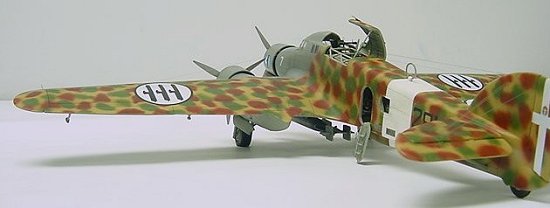 Now that I had drawings, it was time to start the kit.
With the surface of the plastic in such bad shape, I sanded everything down and
removed all of the panel lines (even the ones that marked the decal location).
I thought that the best plan of attack would be to rescribe panel lines as I
assembled the aircraft. Also at this time I began to remove wheel wheels,
doors, and access panels.
Now that I had drawings, it was time to start the kit.
With the surface of the plastic in such bad shape, I sanded everything down and
removed all of the panel lines (even the ones that marked the decal location).
I thought that the best plan of attack would be to rescribe panel lines as I
assembled the aircraft. Also at this time I began to remove wheel wheels,
doors, and access panels.
Next it was time to sand the inside surface of the fuselage and install plastic rod for the internal structural members of the aircraft. At this time I decided to blank off the wing roots and add the structural support for the cockpit floor.
With the foundation installed, installation of the decking, bomb bay doors, and cage around bomb bay was the next logical step. The cockpit floor was the obtained from the photoetch sheet. The photo etch part was made to angle down all the way to the rear fuselage area, making this piece longer than necessary. Instead of chopping off the end I decided to slide the floor forward. This would then give a little extra floor in front of the rudder pedals in case it would be possible to see up through the cockpit. The rear floor of the aircraft had decking put down in the areas were crew traffic would be present. For the rear decking, I decided not to use the photoetch here because the gondola cut out was not correctly shown.
 |
 |
The cage that goes around the bomb bay tubes was constructed
from plastic rod. I started by building the top piece and then later glued in
the vertical pieces. Work was also begun on the other items that needed to be
installed so that a single color could be sprayed at once. The photoetch bits
that go above the windows, the waist gun mounts, the cabinet that is mounted
across from the fuselage door. I also went to the spare parts box and grab a
couple of generic seats and glue in sheet plastic to represent seat cushions.
The bomb tubes and bomb bay doors were constructed at this time.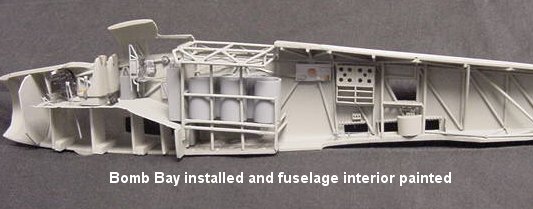
Next, everything was painted in a light gray. The Al’ D’Italia book shows a color drawing of inside of the cockpit to be green. However, at the Cincinnati show several years back an ex-Accurate Miniatures man brought a scratch built 1/32nd SM-79 to display at the show. His interior was gray. In talking to him, he mentioned that he spent some twenty-five years of research to create the model. With this in my head, I began to ask around, and the general consensus was to go gray.
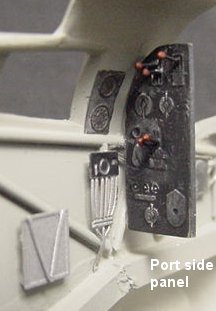 I also put together the other photoetch bits from Eduard.
I did modify the radio and the panel located opposite of the radio in the
fuselage. I thought that thin metal didn’t portray the object’s depth well
enough so some plastic was added. I also install the fuel diversion panel
located on the aft wall of the navigator area. Some brass square stock was
placed in areas where ammo buckets would be located. Some dull cote was sprayed
and a bit of weathering was done.
I also put together the other photoetch bits from Eduard.
I did modify the radio and the panel located opposite of the radio in the
fuselage. I thought that thin metal didn’t portray the object’s depth well
enough so some plastic was added. I also install the fuel diversion panel
located on the aft wall of the navigator area. Some brass square stock was
placed in areas where ammo buckets would be located. Some dull cote was sprayed
and a bit of weathering was done.
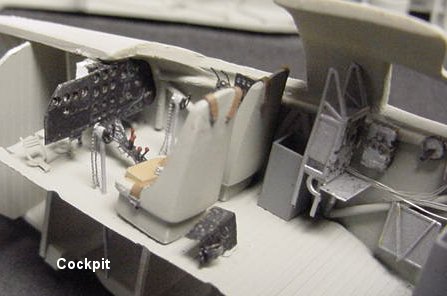 The gondola was something else that I was playing around
with at this time. As you can see in the above pictures, the bottom of the
fuselage has been cut out to accommodate the gondola. I went ahead and
assembled the gondola with the photoetch. However, the front end was not very
accurate. The kit comes with a semi circular shape were all the pictures and
drawings I had seemed to have a more flat, less curved front, not made of glass
with larger side windows. I later would hack off the front of the gondola and
use some spare plastic. In fact I chopped up the clear base the kit comes with
the kit and used them as the new windows (and I thought that that part was going
to be worthless).
The gondola was something else that I was playing around
with at this time. As you can see in the above pictures, the bottom of the
fuselage has been cut out to accommodate the gondola. I went ahead and
assembled the gondola with the photoetch. However, the front end was not very
accurate. The kit comes with a semi circular shape were all the pictures and
drawings I had seemed to have a more flat, less curved front, not made of glass
with larger side windows. I later would hack off the front of the gondola and
use some spare plastic. In fact I chopped up the clear base the kit comes with
the kit and used them as the new windows (and I thought that that part was going
to be worthless).
Engine Nacelles, Wheel Wells, and Propellers
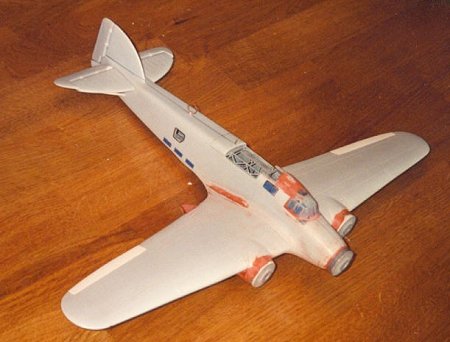 From the outset, I noticed that the kit was going to mount
the landing gear on the under side of the wing. The aircraft actually has a
well in this location. The landing gear actually mounts to the two forward wing
spars and the other support struts mount to the aft spar. A cut out in the wing
was made and plastic pieces where installed to resemble the wing spares. Then the landing gear mounts where build up from there.
From the outset, I noticed that the kit was going to mount
the landing gear on the under side of the wing. The aircraft actually has a
well in this location. The landing gear actually mounts to the two forward wing
spars and the other support struts mount to the aft spar. A cut out in the wing
was made and plastic pieces where installed to resemble the wing spares. Then the landing gear mounts where build up from there.
The engine nacelles seem to pose the most difficultly to build. The kit parts where warped beyond the boiling water trick. I ended up fumbling my way through them and then correcting them with red putty, lots of red putty. At this time the engine plugs where installed and the engines test fitted. One thing missing with the resin cowls are exhausts. No suitable aftermarket items could be located. Therefore, 18” plastic tube was taken, and mitered to the approximate angle and then the edges were smoothed over. The exhaust were then glued to the cowls and a blob of red putty was placed on the front edge and rounded over with a sanding stick to simulate the pipe coming out of the cowl. At the time of these pictures I had all of the exhausts facing the same direction. From pictures this is true of some of the SM-79’s but not of this squadron. I carefully loosened the cowl and rotated it to the correct position.
I also wanted to produce propellers that looked a bit more realistic than what was provided in the kit. So I stole some propeller blades from a B-17 that I plan to later hack up. I cut the props to the correct radius and then sanded them to the correct shape. Although some SM-79’s had small hubs on their props, I knew that I was going to need spinners. I took the Smer prop/spinners, removed the blades and hollowed the spinners to fit over the hub.
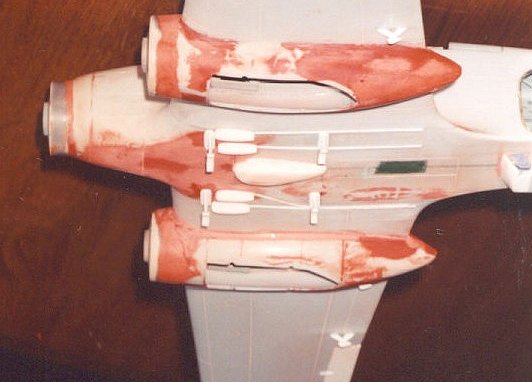 The kit, typical of 60 vintage kits, comes with workable
ailerons, rudder, and elevators. Since I did not like the way these mounted I
filled in the mounting holes and remove the hinged pieces. The rudder was the
easiest to mount. A couple of pieces of plastic strips were inset into the
rudder to simulate hinge points and then glued onto the vertical stab.
The kit, typical of 60 vintage kits, comes with workable
ailerons, rudder, and elevators. Since I did not like the way these mounted I
filled in the mounting holes and remove the hinged pieces. The rudder was the
easiest to mount. A couple of pieces of plastic strips were inset into the
rudder to simulate hinge points and then glued onto the vertical stab.
The elevators needed a little more work. The kit parts had a half circular shape on the portion that butts up against the fuselage. From drawings and pictures, the portion that meets the corner of the horizontal stabs and fuselage is squared off. The arc across this portion was removed; a chunk of evergreen was glued in place, and sanded to shape. Also horizontal support struts were replaced with plastic rod.
The ailerons were the worst piece of the bunch. The parts had major sinkholes as well as the counter balances and had no hinges. I decided to replace it with solid plastic and scratch build the hinges and counter balances.
The landing gear struts that came with kit were as bad as the rest of the smaller pieces. The overall layout seemed to be right, so, new struts were made using the kit parts. When dry fitting the aircraft looked like some redneck was the crew chief and installed a lift package on the front end. Therefore these were simply tossed and new ones were constructed. These were then glued to mounts made in the wells. Then the rest of the struts were added using the diagrams in the Ali D’Italia and Scale Aviation Modeler Magazine Volume 7 Issue 4. The result is a good rendition of the real thing.
 Being that the SM-79 is most famous as a torpedo-bomber, I wanted to show this model as a torpedo
bomber. The SM-79 had provisions to drop two torpedoes. Although early tests
showed that the plane performance dropped dramatically when carrying two
torpedoes. Typically, SM-79’s carried a single torpedo on the port side
mount. Aft of the front mounting bracket their were two humps. This is where
the cables would raise the torpedo from a wheeled cart. Plastic strip, plastic
rod, and a section of plastic tube were used to create these items.
Being that the SM-79 is most famous as a torpedo-bomber, I wanted to show this model as a torpedo
bomber. The SM-79 had provisions to drop two torpedoes. Although early tests
showed that the plane performance dropped dramatically when carrying two
torpedoes. Typically, SM-79’s carried a single torpedo on the port side
mount. Aft of the front mounting bracket their were two humps. This is where
the cables would raise the torpedo from a wheeled cart. Plastic strip, plastic
rod, and a section of plastic tube were used to create these items.The torpedo additions included the addition four fins made of plastic sheet, the cutting of aluminum into prop blades and then plastic sheet to construct the fins aft of the propeller.
 The windows required a little extra TLC. The aft fuselage
widows came as three/two protrusions off a single plug. The windows had
sinkholes on both sides. These were then sanded down and polished out. The
windows were cut out of the plug and then glued into the fuselage from the
outside. Then they were sanded down until the outside was flush with the
fuselage. The same method was employed with the windows in the radio navigator
area.
The windows required a little extra TLC. The aft fuselage
widows came as three/two protrusions off a single plug. The windows had
sinkholes on both sides. These were then sanded down and polished out. The
windows were cut out of the plug and then glued into the fuselage from the
outside. Then they were sanded down until the outside was flush with the
fuselage. The same method was employed with the windows in the radio navigator
area.
The canopy was a completely different animal. First the canopy was smoothed out and polished. Then several coats of future were applied. The canopy shape is still not right. The front three panels of the canopy should be larger and the corner pieces much smaller. However, I still have no vacuform skills and thus something for me to grow on. Overall the canopy still gives a good overall feel. The kit completely missed the glass that is on the fuselage. For this the relevant areas were removed and clear chunks were donated from the clear stand. The pieces were then sanded and polished. The canopy was going to be impossible to dry fit, and, of course, the fit was horrible. So the windows were pre-masked and the canopy glued down. Next red putty was added and sanded in coats until a canopy fit looked “good.”
Generator, Navigation Lights and Pitot Tubes
There are a few other items worth mentioning. The first is the generator located on the starboard side of the aircraft up near the cockpit. This was constructed of 1/8” plastic with aluminum sheet cut into the shape of blades. The mount for these units came in one of two forms, four legs or one horizontal bar. I could support or deny either so the single bar won. Red and Green Plastic were turned down in a drill and then the tips were used as the navigation lights. Two sizes of hypodermic tubing was used to create the pitot tubes
The resin guns were shortened, handles were added, cradles constructed, and sights were added from the photoetch. The dorsal and ventral gun positions are covered by clamshell doors that are opened so that the gun and be aimed at the enemy. These were built from Squadron Thermaform. The thermaform was stretched over a ½” piece of pipe and then the pieces were cut to shape.
|
PAINT & DECALS |
 From the outset, it was narrowed down to one of two paint
schemes, one with the electric man and one with the bluish gray front. The
electric man is a pretty cool looking symbol. However, the paint scheme for the
281st is just unusual. Eventually, with al little help from some friends, the
paint scheme won out. The scheme is a gray underside with a yellow-sand color
on top with blotches of red-browns and greens. Then to aid in hiding from ships
the front edge is painted in a bluish-gray.
From the outset, it was narrowed down to one of two paint
schemes, one with the electric man and one with the bluish gray front. The
electric man is a pretty cool looking symbol. However, the paint scheme for the
281st is just unusual. Eventually, with al little help from some friends, the
paint scheme won out. The scheme is a gray underside with a yellow-sand color
on top with blotches of red-browns and greens. Then to aid in hiding from ships
the front edge is painted in a bluish-gray.
From what I could find, two Squadrons, 179 and 281, used this camouflage. The only difference is that the 179 had camouflage on their cowls and the 281 did not. The sky models sheets came with the 281 so that was the one, I settled on.
 Color plates for this squadron are very easy to find.
Italy’s most famous pilot, Buscaglia, flew their number 5 ship. The color
plates differed greatly in respect to colors and relative size of blotches.
This is where the Colori E Schemi Mimetici Della Regia Aeronautica 1935-1943
book comes in handy. After referring to the color plate for the particular
color scheme, 4 yellows, 4 greens, 3 reds were given as possibilities. Colors
in these ranges were found and used. To solve the botch issue, I went to
pictures. By the looks of things, after the color blotches are painted on most
of the yellow color is covered. In fact it seems that I probably could have
covered it up some more.
Color plates for this squadron are very easy to find.
Italy’s most famous pilot, Buscaglia, flew their number 5 ship. The color
plates differed greatly in respect to colors and relative size of blotches.
This is where the Colori E Schemi Mimetici Della Regia Aeronautica 1935-1943
book comes in handy. After referring to the color plate for the particular
color scheme, 4 yellows, 4 greens, 3 reds were given as possibilities. Colors
in these ranges were found and used. To solve the botch issue, I went to
pictures. By the looks of things, after the color blotches are painted on most
of the yellow color is covered. In fact it seems that I probably could have
covered it up some more.
Then the usual gloss coating ritual took place and decals applied. The Sky sheet is a bit vague (with the references this is easily remedied). It directs the builder to place some of the numbers over the ID band around the fuselage. The sheet also came with a black 5 for the rear fuselage number when I believe it should be red. At this point I stole the red seven and used it. This then required the use of the white sevens and the use of the facis on the centerline cowl. This is the one thing that was definitely different about Buscaglia’s plane than the rest of the squadron. Buscaglia did not facis on the front cowl.
Weathering for this aircraft is light. I didn’t want to cover up the beautiful camouflage. Panel lines were traced using ink and charcoal was used to simulate exhaust and debris here and there on the aircraft.
|
CONCLUSIONS |
Sure this is a difficult kit, and yes there were painful moments in construction. In fact, to keep my sanity, I built a couple other aircraft during this construction just to prove to myself that I could finish something. This kit was a good tool to test my strengths and weaknesses as a modeler. Once in a while it’s good to have a challenge. I probably wouldn’t build another one now that the Classic Airframes kit is around, but to not build a model because a newer kit is available seems a waste.
August 2002
|
REFERENCES |
For this project I used five different reference books. They are as follows;
1. SM-79 In Action Squadron Publications
2. Scale Aviation Modeler Magazine Volume 7 Issue 4
3. S.79 parte 1 Ali D’Italia #9
4. S.79 parte 2 Ali D’Italia#11
5. Colori E Schemi Mimetici Della Regia Aeronautica 1935-1943
Copyright ModelingMadness.com. All rights reserved. No reproduction in any form without express permission from the editor.
If you would like your product reviewed fairly and quickly, please contact the editor or see other details in the Note to Contributors.